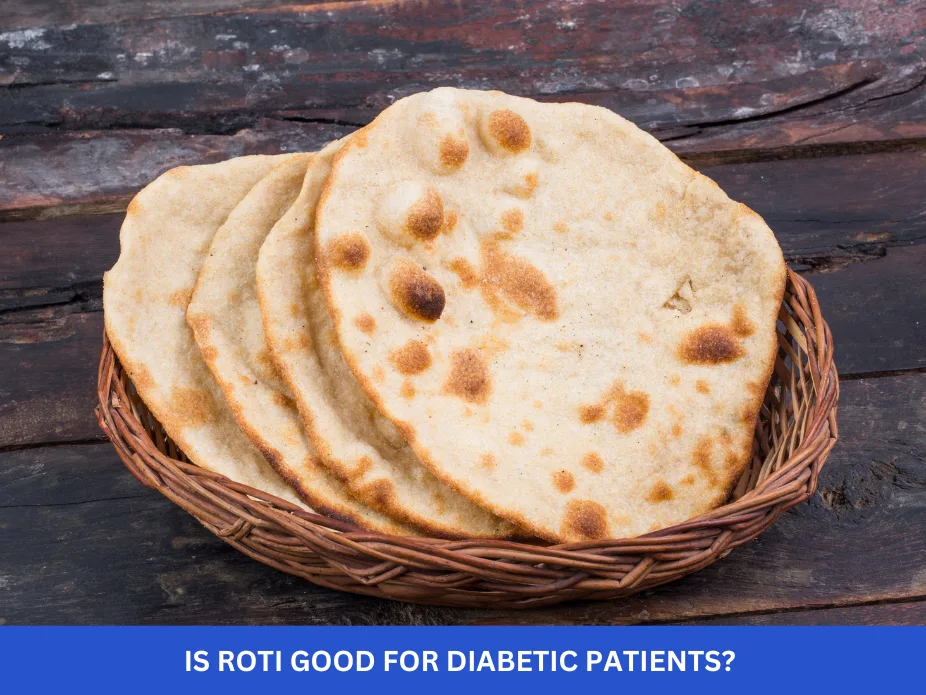When it comes to managing diabetes, food choices play a crucial role. One of the common questions among diabetics is whether traditional foods like roti are suitable for their diet. Roti, a staple in Indian households, is often made from whole wheat, which is considered a healthier option compared to refined flour. But does that mean roti is good for people with diabetes? In this comprehensive guide, we’ll explore the relationship between roti and diabetes, its nutritional content, and how diabetics can enjoy it without causing harm to their health.
What is Roti?
Roti, also known as chapati, is a flatbread made primarily from whole wheat flour, water, and salt. It is a key part of the Indian diet, often served alongside vegetables, curries, and dals. Roti is made by kneading dough and rolling it out into thin circles before being cooked on a hot tawa or griddle. Though it’s simple, roti can be a healthy choice when prepared correctly, especially for individuals with diabetes.
The Impact of Roti on Blood Sugar Levels
Glycemic Index and Diabetes
The glycemic index (GI) measures how quickly a food item raises blood sugar levels. Foods with a high GI cause rapid spikes in blood sugar, while foods with a low GI release sugar slowly into the bloodstream. For people with diabetes, it is important to focus on low-GI foods to avoid blood sugar spikes.
Whole wheat roti typically has a moderate GI of around 60-65, which is lower than foods made from refined flour (maida). This means that it doesn’t cause an immediate spike in blood sugar levels, making it a more diabetic-friendly choice compared to processed foods like white bread. However, roti’s GI can be influenced by various factors such as how it’s prepared and served, and portion sizes.
Carbohydrates and Diabetes
Roti is primarily composed of carbohydrates, which are broken down into glucose in the body. For individuals with diabetes, managing carbohydrate intake is essential for controlling blood sugar. While roti can fit into a diabetic meal plan, portion control is crucial.
One medium-sized whole wheat roti contains approximately 15-20 grams of carbohydrates. Depending on the type of diabetes, the individual’s activity level, and the rest of their meal, it is important to monitor carbohydrate intake to prevent high blood sugar levels.
Is Roti Good for Diabetic Patients?
Roti, a staple in many Indian diets, is made from whole wheat flour and is a source of complex carbohydrates. For diabetic patients, it can be a healthier option compared to refined flour products, as it has a lower glycemic index and releases sugar slowly into the bloodstream. Portion control and pairing with protein or fiber-rich foods can help manage blood sugar levels effectively.
Types of Roti and Their Suitability for Diabetics
Not all types of roti are the same. The flour used and the way the roti is prepared can affect its glycemic index and its impact on blood sugar. Let’s take a look at different types of roti and how they affect diabetes management.
Whole Wheat Roti
Whole wheat roti is the most common type and is made from whole wheat flour, which contains the entire grain. It is rich in fiber, which helps in slowing down the absorption of sugar, making it a better option for people with diabetes compared to white flour roti. The fiber content also aids in digestion and helps keep you full longer, preventing overeating.
Multigrain Roti
Multigrain roti is made from a mixture of different flours, such as wheat, millet, barley, and oats. The addition of these grains increases the nutritional value and lowers the glycemic index of the roti. Multigrain roti is a great option for diabetics as it provides a range of nutrients, including fiber, protein, and essential vitamins and minerals, which support overall health.
Bajra (Pearl Millet) Roti
Bajra roti is made from pearl millet flour, which is high in fiber and has a lower glycemic index compared to whole wheat. Bajra is rich in magnesium and zinc, which are important for managing blood sugar levels. This makes bajra roti an excellent choice for people with diabetes. Additionally, it is gluten-free, making it suitable for those who are sensitive to gluten.
Jowar (Sorghum) Roti
Jowar roti is made from sorghum flour, which is another gluten-free option. It has a low glycemic index and is packed with nutrients such as fiber, protein, and antioxidants. Jowar is known to help regulate blood sugar levels, making it a beneficial food for diabetics. It is also high in iron, which helps combat anemia, a common concern among diabetics.
Ragi (Finger Millet) Roti
Ragi, or finger millet, is another excellent choice for diabetics. It is rich in calcium, fiber, and essential amino acids. Ragi has a low glycemic index and helps in controlling blood sugar levels by slowing down the absorption of glucose. Ragi roti is particularly beneficial for individuals with type 2 diabetes, as it helps improve insulin sensitivity.
How to Include Roti in a Diabetic-Friendly Diet
While roti can be part of a healthy diet for people with diabetes, it’s essential to keep a few things in mind:
1. Control Portion Size
The key to including roti in your diabetic diet is portion control. It’s easy to overeat, especially when roti is served alongside other high-carb foods. Stick to one or two small roti with a balanced meal that includes vegetables, lean proteins, and healthy fats.
2. Pair with Vegetables and Lean Proteins
To make your meal more diabetic-friendly, pair your roti with a variety of vegetables and lean proteins like chicken, fish, or legumes. This helps in balancing the overall glycemic load of the meal, which can prevent blood sugar spikes. Vegetables like spinach, cauliflower, and bottle gourd (lauki) are particularly beneficial for diabetics due to their low carbohydrate content.
3. Choose Whole Wheat or Multigrain
As mentioned earlier, whole wheat and multigrain roti are better options than white flour roti. If you are looking to further lower the glycemic index, you can opt for multigrain flour or flour blends that include millets like bajra, jowar, or ragi.
4. Avoid Fried Roti
Avoid preparing roti with excessive oil or ghee, as this can add unnecessary calories and unhealthy fats. Instead, opt for dry or lightly brushed versions, which are healthier and won’t lead to weight gain or other complications associated with diabetes.
5. Watch for Hidden Sugars
Sometimes, roti is served with sugary condiments like chutneys or pickles. These can contribute to a sudden increase in blood sugar. Opt for sugar-free or homemade options to avoid added sugars in your meal.
Can Diabetic Patients Eat Roti Every Day?
The answer to this depends on the individual’s health condition and dietary needs. For most people with well-controlled diabetes, having roti every day can be part of a healthy diet. However, it’s important to monitor your blood sugar levels regularly to ensure that your carbohydrate intake is not causing any spikes. As with any food, moderation and variety are key.
Can Diabetics Eat Roti for Dinner?
Yes, diabetics can eat roti for dinner, but it is essential to keep the portion size in check. A light meal consisting of one or two roti with vegetables and lean proteins is a good choice for dinner. It’s important to avoid heavy or high-fat curries that may increase the glycemic load of the meal.
Best Time to Eat Roti for Diabetics
While roti can be eaten at any time of the day, it’s best to consume it earlier in the day when the body is more active and can efficiently utilize the carbohydrates. Having roti for breakfast or lunch, along with a balanced meal, can help in controlling blood sugar throughout the day.
Real-Life Scenario
Consider a diabetic patient, Priya, who replaced white bread with whole wheat roti in her meals. Over a few months, she noticed more stable blood sugar readings and improved energy levels. This simple dietary change illustrates how incorporating roti mindfully can support diabetes management.
Expert Contribution
Nutritionists emphasize that while roti is generally safe for diabetics, the key lies in moderation. Dr. Anjali Mehta, a certified dietitian, suggests combining roti with vegetables, legumes, or lean protein to slow carbohydrate absorption and maintain balanced blood glucose levels.
Recommendations Grounded in Proven Research and Facts
- Prefer whole wheat or multigrain roti over refined flour variants.
- Limit intake to 1–2 rotis per meal based on individual carbohydrate needs.
- Pair roti with fiber-rich vegetables, dals, or lean proteins to stabilize blood sugar.
- Avoid excessive ghee or oil on roti to reduce added calories and fat.
Frequently Asked Questions (FAQs) on Is Roti Good for Diabetic Patients?
1. Is whole wheat roti good for diabetics?
Yes, whole wheat roti is a better option for diabetics compared to refined flour roti. It contains more fiber, which helps slow down sugar absorption and maintain stable blood sugar levels.
2. Can I eat roti if I have type 2 diabetes?
Yes, you can eat roti if you have type 2 diabetes, but portion control and pairing it with low-glycemic foods like vegetables and lean proteins are important for managing blood sugar levels.
3. Which roti is best for diabetics?
Whole wheat, multigrain, bajra, jowar, and ragi rotis are all excellent choices for diabetics. These varieties are low in glycemic index and high in fiber, making them suitable for controlling blood sugar levels.
4. How many rotis can a diabetic eat in a day?
The number of rotis a diabetic can eat in a day depends on their individual carbohydrate requirements, activity levels, and how well their blood sugar is controlled. Generally, 1-2 small-sized rotis per meal is a good starting point.
5. Can I eat roti with curry if I have diabetes?
Yes, you can eat roti with curry, but choose low-fat, non-sugary, and low-carb curries. Opt for vegetable-based or lean protein-based curries instead of those rich in cream or sugar.
Conclusion
Roti can be part of a healthy and balanced diet for diabetics, as long as it is consumed in moderation and paired with the right foods. Opt for whole wheat or multigrain roti, control portion sizes, and avoid fried versions. By making informed choices and focusing on a diabetic-friendly meal plan, you can enjoy this beloved Indian staple without compromising your health.


